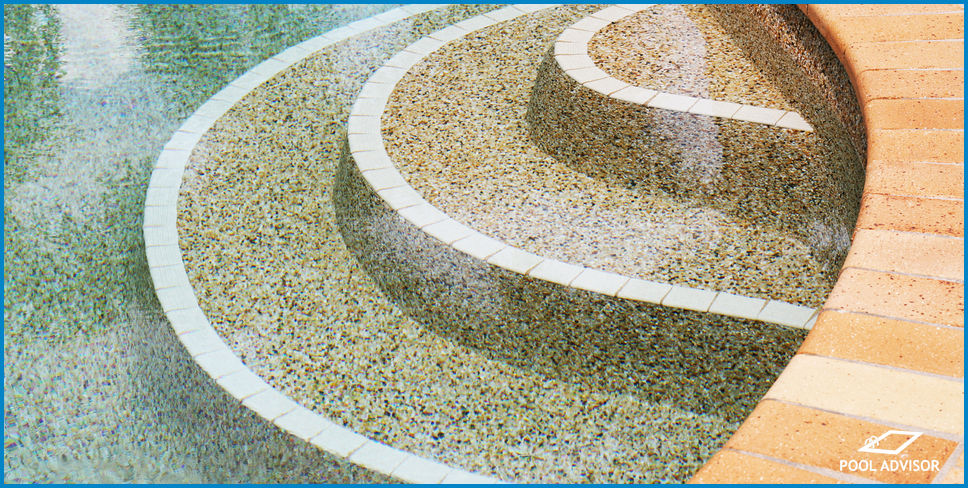
Pebblecrete Pool Problems - What Are They?
Pebblecrete pools are a popular type of pool among those seeking a more natural appearance.
Despite the popularity of this pool type, pebblecrete pools are prone to their own problems. In this article we will review some of the most common problems with pebblecrete pools, as well as what you can do to prevent these.
Problems With Pebblecrete Pools
Rough Surfaces
One problem that occurs with pebblecrete pools is rough surfaces. When your pebblecrete pool lining is new, the surfaces should be mostly smooth. This is because the cement portion of the pebblecrete mixture acts as grout between the pebbles, creating a mostly even surface.
The problem happens when this cement begins to deteriorate. This happens naturally with time, but can be accelerated by inadequate water chemistry.
As the cement grout deteriorates, the pebbles are left behind, which can create a rather rough and gravely surface that resembles miniature cobblestone.
These surfaces can become uncomfortable for swimmers, especially if these areas lie at the floor of the pool, and the rough texture of the lining can also complicate the cleaning process.
Algae Growth
Algae growth is known to be more difficult to treat in pebblecrete pools. Due to the rough texture of pebblecrete lining, especially once the cement mortar has begun to deteriorate, algae cells can attach to the walls of your pool and will find many nooks and crannies to hide in.
Certain stubborn types of algae, such as black spot algae, are especially good at attaching themselves to rough surfaces.
These properties make this strain very difficult to remove from the surfaces of a pebblecrete pool. If scrubbing is needed during the algae removal process, it will require much more manual labour compared to other types of pool lining.
Broken Pieces Of Pebblecrete
As the cement of your pebblecrete surface begins to deteriorate, portions of pebblecrete may crack, flake, or otherwise become loosened from the outer shell of your pool. In more extreme cases, pieces of pebblecrete begin to break off.
This breakage is especially bad because it allows pool water to work its way behind other pieces of your pebblecrete surface, which can rapidly turn a small portion of broken lining into a big problem.
A complete pebblecrete resurfacing may be required to fix this problem.
Scale
Calcium deposits or stains, most often referred to as scale, are also more likely in pebblecrete pools.
This is because the natural pebbles used to construct the pool lining are high in minerals and may include calcium themselves. As the load of dissolved minerals slowly increases in your pool’s water, the likelihood of scale forming increases drastically.
Scale is even more likely to occur in older pebblecrete pools. This is because as the cement grout between the pebbles slowly deteriorates, minerals from this cement and from the newly exposed pebble surfaces are gradually added to the water.
Much like black spot algae, calcium scale is more challenging to remove from pebblecrete pools than other pool surfaces.
Avoiding Pebblecrete Pool Problems
Balance Water Chemistry
Maintaining ideal water chemistry is the number one step that owners of pebblecrete pools can take to ensure the longevity of their pool’s lining.
Many elements of your pool’s chemistry can develop corrosive properties if balanced incorrectly, making it necessary to check several levels of your water on a regular basis.
You should ensure that your pH and total alkalinity are 7.2-7.6 and 80-120 parts per million (ppm) respectively. You should have a chlorine level no higher than 4 ppm, and should also measure the calcium hardness of your water, which should fall between 200-400 ppm.
Preventing Algae
The best way to combat algae in a pebblecrete pool is to take preventative measures to keep it from developing in the first place.
To do this, you should be maintaining consistent levels of free chlorine in your pool ranging from 2-4 ppm. You should also use an algaecide as a preventative measure.
Pool Drops Algaecide can be a good option for pebblecrete pools. This algaecide is highly concentrated, and when used preventatively, it works to kill off any algae cells that may be present in your water before they have a chance to spread.

Louis
A chemical engineer by trade, Louis is committed to debunking myths in the pool industry by explaining the underlying chemistry and making it accessible to all.
